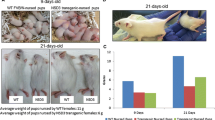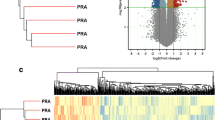Abstract
Microarray studies revealed that as a first hit the SV40 T/t antigen causes deregulation of 462 genes in mammary gland cells (ME cells) of WAP-SVT/t transgenic animals. The majority of deregulated genes are cell proliferation specific and Rb-E2F dependent, causing ME cell proliferation and gland hyperplasia but not breast cancer formation. In the breast tumor cells a further 207 genes are differentially expressed, most of them belonging to the cell communication category. In tissue culture breast tumor cells frequently switch off WAP-SVT/t transgene expression and regain the morphology and growth characteristics of normal ME cells, although the tumor-revertant cells are aneuploid and only 114 genes regain the expression level of normal ME cells. The profile of retransformants shows that only 38 deregulated genes are tumor-specific, and that none of them is considered to be a typical breast cancer gene.






Similar content being viewed by others
Abbreviations
- CA :
-
Correspondence analysis
- DMEM :
-
Dulcecco’s modified Eagle medium
- IRF :
-
Interferon regulatory factor
- ME :
-
Mammary gland epithelial
- OAS :
-
2′-5′-Oligoadenylate synthetase family members
- PBS :
-
Phosphate-buffered saline
- SV40 :
-
Simian virus 40
- WAP :
-
Whey acidic milk protein
References
Loeb LA, Loeb KR, Anderson JP (2003) Multiple mutations and cancer. Proc Natl Acad Sci USA 100:776–781
Oesterreich S, Fuqua SA (1999) Tumor suppressor genes in breast cancer. Endocr Relat Cancer 6:405–419
Hulit J, Lee RJ, Russell RG, Pestell RG (2002) ErbB-2-induced mammary tumor growth: the role of cyclin D1 and p27Kip1. Biochem Pharmacol 64:827–836
Ness SA (1996) The Myb oncoprotein: regulating a regulator. Biochim Biophys Acta 1288:123–139
Perou CM, Sorlie T, Eisen MB, van de Rijn M, Jeffrey SS, Rees CA, Pollack JR, Ross DT, Johnsen H, Akslen LA, Fluge O, Pergamenschikov A, Williams C, Zhu SX, Lonning P, Borresen-Dale AL, Brown PO, Botstein D (2000) Molecular portraits of human breast tumours. Nature 406:747–752
Graessmann M, Graessman A (1976) “Early” simian-virus-40-specific RNA contains information for tumor antigen formation and chromatin replication. Proc Natl Acad Sci USA 73:366–370
Ali SH, DeCaprio JA (2001) Cellular transformation by SV40 large T antigen: interaction with host proteins. Semin Cancer Biol 11:15–23
Klein A, Guhl E, Tzeng YJ, Fuhrhop J, Levrero M, Graessmann M, Graessmann A (2003) HBX causes cyclin D1 overexpression and development of breast cancer in transgenic animals that are heterozygous for p53. Oncogene 22:2910–2919
Tzeng YJ, Guhl E, Graessmann M, Graessmann A (1993) Breast cancer formation in transgenic animals induced by the whey acidic protein SV40 T antigen (WAP-SV-T) hybrid gene. Oncogene 8:1965–1971
Tzeng YJ, Zimmermann C, Guhl E, Berg B, Avantaggiati ML, Graessmann A (1998) SV40 T/t-antigen induces premature mammary gland involution by apoptosis and selects for p53 missense mutation in mammary tumors. Oncogene 16:2103–2114
DeGregori J (2002) The genetics of the E2F family of transcription factors: shared functions and unique roles. Biochim Biophys Acta 1602:131–150
Donehower LA, Harvey M, Slagle BL, McArthur MJ, Montgomery CA Jr, Butel JS, Bradley A (1992) Mice deficient for p53 are developmentally normal but susceptible to spontaneous tumours. Nature 356:215–221
Pun T, Hochstrasser DF, Appel RD, Funk M, Villars-Augsburger V, Pellegrini C (1988) Computerized classification of two-dimensional gel electrophoretograms by correspondence analysis and ascendant hierarchical clustering. Appl Theor Electrophor 1:3–9
Fellenberg K, Hauser N, Brors B, Neutzner A, Hoheisel JD, Vingron M (2001) Correspondence analysis applied to microarray data. Proc Natl Acad Sci USA 98:10781–10786
Graessmann M, Michaels G, Berg B, Graessmann A (1991) Inhibition of SV40 gene expression by microinjected small antisense RNA and DNA molecules. Nucleic Acids Res 19:53–58
Santarelli R, Tzeng YJ, Zimmermann C, Guhl E, Graessmann A (1996) SV40 T-antigen induces breast cancer formation with a high efficiency in lactating and virgin WAP-SV-T transgenic animals but with a low efficiency in ovariectomized animals. Oncogene 12:495–505
Lamote I, Meyer E, Massart-Leen AM, Burvenich C (2004) Sex steroids and growth factors in the regulation of mammary gland proliferation, differentiation, and involution. Steroids 69:145–159
Goetz F, Tzeng YJ, Guhl E, Merker J, Graessmann M, Graessmann A (2001) The SV40 small t-antigen prevents mammary gland differentiation and induces breast cancer formation in transgenic mice; truncated large T-antigen molecules harboring the intact p53 and pRb binding region do not have this effect. Oncogene 20:2325–2332
Hernando E, Nahle Z, Juan G, Diaz-Rodriguez E, Alaminos M, Hemann M, Michel L, Mittal V, Gerald W, Benezra R, Lowe SW, Cordon-Cardo C (2004) Rb inactivation promotes genomic instability by uncoupling cell cycle progression from mitotic control. Nature 430:797–802
Zhou A, Hassel BA, Silverman RH (1993) Expression cloning of 2–5A-dependent RNAase: a uniquely regulated mediator of interferon action. Cell 72:53–65
Rogozin IB, Aravind L, Koonin EV (2003) Differential action of natural selection on the N and C-terminal domains of 2′-5′ oligoadenylate synthetases and the potential nuclease function of the C-terminal domain. J Mol Biol 326:1449–‘1461
Ghosh A, Sarkar SN, Rowe TM, Sen GC (2001) A specific isozyme of 2′-5′ oligoadenylate synthetase is a dual function proapoptotic protein of the Bcl-2 family. J Biol Chem 276:25447–25455
Kohlhoff S, Ziechmann C, Gottlob K, Graessmann M (2000) SV40 T/t-antigens sensitize mammary gland epithelial cells to oxidative stress and apoptosis. Free Radic Biol Med 29:497–506
Zhang L, Pagano JS (2002) Structure and function of IRF-7. J Interferon Cytokine Res 22:95–101
Avantaggiati ML, Carbone M, Graessmann A, Nakatani Y, Howard B, Levine AS (1996) The SV40 large T antigen and adenovirus E1a oncoproteins interact with distinct isoforms of the transcriptional co-activator, p300. EMBO J 15:2236–2248
Caillaud A, Prakash A, Smith E, Masumi A, Hovanessian AG, Levy DE, Marie I (2002) Acetylation of interferon regulatory factor-7 by p300/CREB-binding protein (CBP)-associated factor (PCAF) impairs its DNA binding. J Biol Chem 277:49417–49421
Lubyova B, Kellum MJ, Frisancho AJ, Pitha PM (2004) Kaposi’s sarcoma-associated herpesvirus-encoded vIRF-3 stimulates the transcriptional activity of cellular IRF-3 and IRF-7. J Biol Chem 279:7643–7654
Hamerman JA, Hayashi F, Schroeder LA, Gygi SP, Haas AL, Hampson L, Coughlin P, Aebersold R, Aderem A (2002) Serpin 2a is induced in activated macrophages and conjugates to a ubiquitin homolog. J Immunol 168:2415–2423
Malakhov MP, Kim KI, Malakhova OA, Jacobs BS, Borden EC, Zhang DE (2003) High-throughput immunoblotting. Ubiquitiin-like protein ISG15 modifies key regulators of signal transduction. J Biol Chem 278:16608–16613
Padovan E, Terracciano L, Certa U, Jacobs B, Reschner A, Bolli M, Spagnoli GC, Borden EC, Heberer M (2002) Interferon stimulated gene 15 constitutively produced by melanoma cells induces e-cadherin expression on human dendritic cells. Cancer Res 62:3453–3458
Linforth R, Anderson N, Hoey R, Nolan T, Downey S, Brady G, Ashcroft L, Bundred N (2002) Coexpression of parathyroid hormone related protein and its receptor in early breast cancer predicts poor patient survival. Clin Cancer Res 8:3172–177
Hubert RS, Vivanco I, Chen E, Rastegar S, Leong K, Mitchell SC, Madraswala R, Zhou Y, Kuo J, Raitano AB, Jakobovits A, Saffran DC, Afar DE (1999) STEAP: a prostate-specific cell-surface antigen highly expressed in human prostate tumors. Proc Natl Acad Sci USA 96:14523–14528
Yang D, Holt GE, Velders MP, Kwon ED, Kast WM (2002) Murine six-transmembrane epithelial antigen of the prostate, prostate stem cell antigen, and prostate-specific membrane antigen: prostate-specific cell-surface antigens highly expressed in prostate cancer of transgenic adenocarcinoma mouse prostate mice. Cancer Res 61:5857–58560
Acknowledgements
This work was supported by the Verband der Chemischen Industrie. We thank Dr. A. Corfield for critical reading of the manuscript.
Author information
Authors and Affiliations
Corresponding author
Electronic Supplementary Material
Rights and permissions
About this article
Cite this article
Klein, A., Guhl, E., Zollinger, R. et al. Gene expression profiling: cell cycle deregulation and aneuploidy do not cause breast cancer formation in WAP-SVT/t transgenic animals. J Mol Med 83, 362–376 (2005). https://doi.org/10.1007/s00109-004-0625-1
Received:
Accepted:
Published:
Issue Date:
DOI: https://doi.org/10.1007/s00109-004-0625-1




